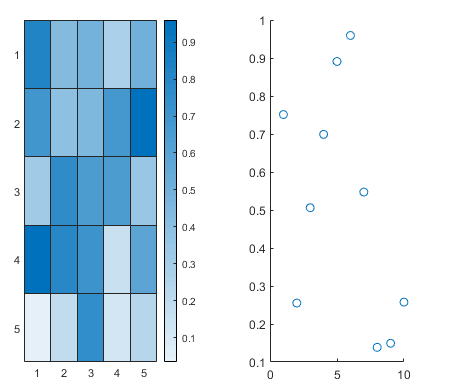rendererinfo
Graphics renderer information
Description
info = rendererinfo
info = rendererinfo(target)target as any type of axes or a standalone visualization. You
can also specify an array of n axes or standalone visualizations, in
which case info is returned as a 1-by-n structure array.
Examples
Get the default renderer information for the current session.
info = rendererinfo
info = struct with fields:
GraphicsRenderer: 'WebGL'
Vendor: 'Google Inc. (Google)'
Version: 'WebGL 2.0 (OpenGL ES 3.0 Chromium)'
RendererDevice: 'ANGLE (Google, Vulkan 1.3.0 (SwiftShader Device (Subzero) (0x0000C0DE)), SwiftShader driver)'
Details: [1×1 struct]
Create a surface plot of the peaks function.
surf(peaks)

Get the current axes, and then get renderer information for the axes. Your system might return different information.
ax = gca; info = rendererinfo(ax)
info =
struct with fields:
GraphicsRenderer: 'WebGL'
Vendor: 'Google Inc. (NVIDIA)'
Version: 'WebGL 2.0 (OpenGL ES 3.0 Chromium)'
RendererDevice: 'ANGLE (NVIDIA, NVIDIA Quadro P600 (0x00001CB2) Direct3D11 vs_5_0 ps_5_0, D3D11)'
Details: [1×1 struct]
Get the driver details.
info.Details
ans =
struct with fields:
HardwareSupportLevel: 'Full'
SupportsDepthPeelTransparency: 1
SupportsAlignVertexCenters: 1
SupportsGraphicsSmoothing: 1
MaxTextureSize: 16384
MaxFrameBufferSize: 16384Create a heatmap chart and a scatter plot in a figure.
tiledlayout(1,2) nexttile h = heatmap(rand(5)); ax1 = nexttile; scatter(ax1,1:10,rand(1,10))

Get the renderer information for the heatmap chart and the parent axes of the
scatter plot. In this case, info is an array that contains two
structures.
info = rendererinfo([h ax1])
info =
1×2 struct array with fields:
GraphicsRenderer
Vendor
Version
RendererDevice
DetailsIndex into the array to get the renderer version for the heatmap chart. Your system might return different version information.
info(1).Version
ans =
'WebGL 2.0 (OpenGL ES 3.0 Chromium)'Input Arguments
Target object, specified as one of the following:
Any type of axes, such as an
Axes,PolarAxes, orGeographicAxesobject.A standalone visualization, such as a
heatmap.An array of axes, standalone visualizations, or a combination of them.
Output Arguments
Renderer information, returned as a structure that contains information such as the
name of the graphics renderer, vendor, and version. The Details field
is a nested structure that contains additional details. Both the info
structure and the info.Details structure are described in the tables
below.
If you specify target as an array of n axes
or standalone visualizations, info is returned as a 1-by-n
structure array. Each structure in the array corresponds to an element of
target.
Info Structure
All systems return these fields.
| Field | Description |
|---|---|
GraphicsRenderer | Graphics renderer, returned as one of these values:
|
Vendor | Manufacturer of the graphics renderer implementation. |
Version | Version of the graphics renderer implementation. |
RendererDevice | Device that supports the graphics renderer. If you are using hardware-accelerated graphics, this field is the graphics card model name. |
Details | Nested structure that contains additional details, such as the renderer's driver version. For the Painters renderer, this structure is empty. |
Details Structure
The Details structure has these fields.
Before R2025a: Some systems return a subset of these fields, depending on the graphics renderer.
| Field | Description |
|---|---|
HardwareSupportLevel | Hardware support level, returned as one of these values:
|
SupportsDepthPeelTransparency | Depth peel transparency feature support, returned as
|
SupportsAlignVertexCenters | Align vertex centers feature support, returned as
|
SupportsGraphicsSmoothing | Graphics smoothing feature support, returned as
|
MaxTextureSize | Maximum texture size that the renderer supports (in pixels). |
MaxFrameBufferSize | Maximum frame buffer size that the renderer supports (in pixels). |
Version History
Introduced in R2019aAll systems that support running MATLAB also support most of the common MATLAB graphics features, such as graphics smoothing and aligned vertex centers.
Before R2025a: See Advanced Graphics Features for information about these features and whether your system supports them.
The nested Details structure no longer contains the
RendererDriverVersion and RendererDriverReleaseDate
fields.
Call the rendererinfo function without any arguments to query the
default graphics renderer information. This new syntax allows you to call the
rendererinfo function in a way that is consistent with the
opengl syntax.
rendererinfo can provide renderer information for a specific axes
or standalone visualization, and it can report information about the WebGL™ renderer. The opengl function does not provide these
features.
MATLAB Command
You clicked a link that corresponds to this MATLAB command:
Run the command by entering it in the MATLAB Command Window. Web browsers do not support MATLAB commands.
Website auswählen
Wählen Sie eine Website aus, um übersetzte Inhalte (sofern verfügbar) sowie lokale Veranstaltungen und Angebote anzuzeigen. Auf der Grundlage Ihres Standorts empfehlen wir Ihnen die folgende Auswahl: .
Sie können auch eine Website aus der folgenden Liste auswählen:
So erhalten Sie die bestmögliche Leistung auf der Website
Wählen Sie für die bestmögliche Website-Leistung die Website für China (auf Chinesisch oder Englisch). Andere landesspezifische Websites von MathWorks sind für Besuche von Ihrem Standort aus nicht optimiert.
Amerika
- América Latina (Español)
- Canada (English)
- United States (English)
Europa
- Belgium (English)
- Denmark (English)
- Deutschland (Deutsch)
- España (Español)
- Finland (English)
- France (Français)
- Ireland (English)
- Italia (Italiano)
- Luxembourg (English)
- Netherlands (English)
- Norway (English)
- Österreich (Deutsch)
- Portugal (English)
- Sweden (English)
- Switzerland
- United Kingdom (English)